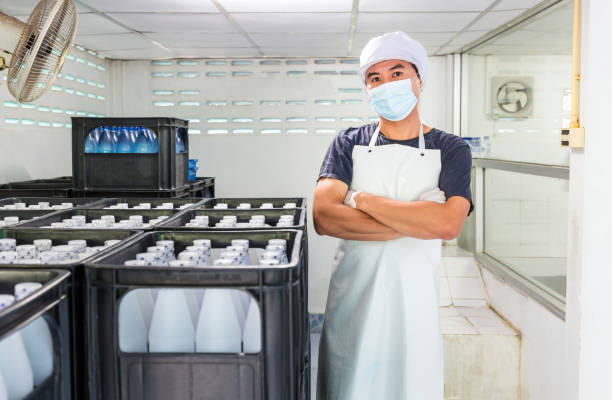Cleaning and disinfection in the food industry
Cleaning and disinfection in the food industry
Food hygiene is the set of measures that must be taken during all stages of food processing to prevent food poisoning and ensure safety when consuming them.

In this article we show you which are the most common bacteria present in food, the step by step for correct food hygiene to prevent food poisoning, and a recommendation of products that you can use totally safe.
What are we gonna see?
1.- What is food hygiene?
2.- Most common bacteria in food.
3.- How to prevent food poisoning?
4.- Steps for correct cleaning and disinfection in the food industry.
5.- Chemical products for food hygiene.
What is food hygiene?
According to the World Health Organization, food hygiene can be defined as the set of conditions and measures that must be present at all stages of production, storage, transformation, transport, preservation, and domestic cooking of food, to guarantee the healthiness of food. themselves. The consumer must know how to choose and recognize the quality of food, as well as how to preserve and handle it properly to avoid contamination and loss of quality.
The main objective is to avoid the alteration of food, maintaining all its properties (taste, smell, texture…), and thus avoid the appearance of food-borne diseases, which are those that occur after the consumption of contaminated food.
Most common bacteria in food
When bacteria contaminate food, food poisoning occurs. The major symptoms are diarrhea, abdominal pain, vomiting, nausea, and fever.
These bacteria are not perceptible to the naked eye, so good practices in food handling, as well as proper hygiene of kitchen equipment, surfaces, and tools are essential to prevent poisoning.
These are the most common bacteria present in food:
- Staphylococcus aureus: Present mainly in protein-rich cooked foods, as well as dairy products and pastry creams. Contamination can occur when food is stored at room temperature.
- Salmonella: this bacterium is one of the major causes of food poisoning. It is found mostly in raw meat, eggs, and unpasteurized milk.
- E-coli: it is in the digestive system of humans and animals. It is present above all in raw meats and contaminated water. To avoid it, it is important to cook all food well, not drink raw milk or non-potable water, and disinfect vegetables that are going to be eaten raw.
- Campylobacter: This is especially present in raw poultry and raw fish, so it is important to cook these foods thoroughly and avoid cross-contamination with other foods.
- Listeria oncogenes: Multiplies rapidly in refrigerated, ready-to-eat foods, unpasteurized milk, vegetables, or canned goods. To prevent it, it is recommended not to store vegetables for a long time and to carry out rigorous hygiene in the fridge.
How to prevent food poisoning?
Food poisoning diseases produce very unpleasant symptoms, and can sometimes pose a serious health risk. To avoid them, it is important to carry out a series of good practices throughout the food preparation process.
Cleaning
- Everyone who is in contact with food must always maintain proper hygiene. Let’s remember that hands are the main vehicle for transmitting bacteria, so it is essential to clean and disinfect them on a continuous basis.
- Cleaning work surfaces and tools after use will prevent the spread of bacteria through cross-contamination.
- Wear gloves to avoid contact with food from possible sores or wounds.
- Use cutting boards made of non-porous material and always wash them after each use.
Elaboration
- Select quality food and buy from trusted suppliers.
- Separate raw foods from those ready to use, both during the handling process and in storage. To do this, use different cutting boards and store raw products in the lower part of the refrigerator to avoid contaminating food that is already ready for use.
- To kill bacteria present in food, cook it at the right temperature and for the right time. Make sure the food is fully cooked.
- Ensure access to drinking water for preparing recipes.
- In the case of raw food, such as vegetables and fruits, it is advisable to use a food disinfectant to eliminate any bacteria that may exist.
Conservation
- Do not leave prepared foods at room temperature for more than two hours.
- Never thaw food at room temperature, always in the refrigerator.
Steps for correct cleaning and disinfection in the food industry.
First, it is convenient to differentiate between cleaning and disinfection. Cleaning involves the removal of grease, visible residues, and organic remains through the use of water and detergents. Disinfection comprises eliminating bacteria we cannot see with the naked eye. It is always carried out after cleaning, always using disinfectants allowed for the food industry.
These are the steps you must follow to achieve proper food hygiene and disinfection:
1.- Elimination of the most visible dirt, food remains, and waste.
2.- Application of pressurized water to remove any remains that may have remained on the equipment.
3.- Use of a detergent that dissolves encrusted dirt and layers of grease. It is recommended, in this step, the use of brushes or sponges to remove the most persistent dirt.
4.- Rinse with pressurized water to remove any traces of detergent.
5.- Disinfect by using specific products for the food industry, always following the manufacturer’s instructions.
6.- Final rinse with potable water to remove all traces of chemical products.
7.- Drying by using dry air or clothes to avoid favorable conditions for the recontamination of the surfaces.
Chemicals for food hygiene
When choosing the chemical products to use for cleaning equipment and surfaces that come into contact with food, it is essential that they have the HA indicative in the registration number, so it is suitable for food use.
In addition, each product must be accompanied by the technical data sheet, which shows its characteristics and its method of use; as well as the safety sheet that exposes aspects such as: toxicological information, physical and chemical properties, first aid, hazard identification or handling and storage, among others.



